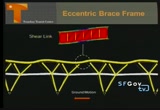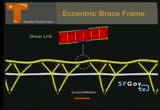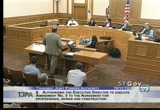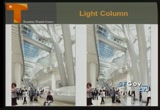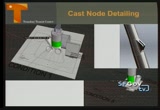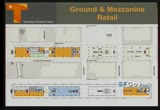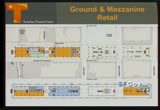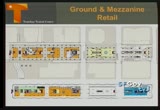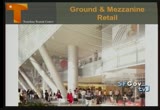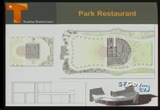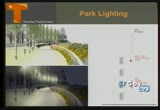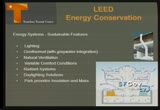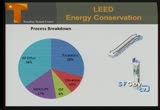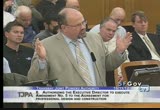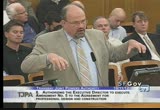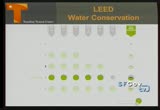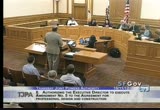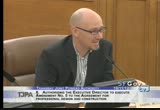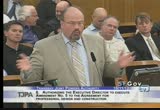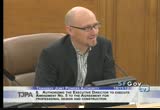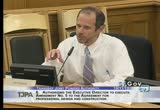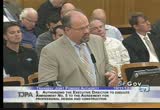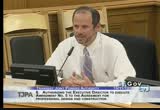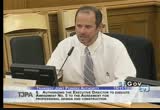tv [untitled] October 11, 2012 9:30pm-10:00pm PDT
9:30 pm
respond in an earthquake. and where that sheer length absorbs the stresses, so that that can be damaged and in a predictable manner and repaired following a seismic event. but that the transit center structure would not be compromised and we could remain operational. >> so, here is some photographs. >> we do have one question. >> does that sheering link get replaced if it is damaged? >> yeah, in a maximum after a maximum credible dent you would want to repair that because there is some yielding as you can see in this diagram, but it is not yielding to the point of failure. and so, it is just, it is where you intend to accumulate those stresses and that will really only be in the 700-year type of event, 100-year, event, something less than magnitude 7
9:31 pm
would not damage this. >> and is this vertical through the building? >> these are at the tops of the basket columns between the individual base, so this is kind of the most in that longitudinal motion along the length of the building, this is the location of the highest stress and so this was the designed location for these stresses to accumulate in a way that we could control them and insure the survival and continued the operation of the facility with minor repairs following an event. >> did you say, continue, the area will be so visible, i mean it will not have to shut it down or anything like that? >> no. thank you for the question, because i wanted to say that we are, our structural and seismic review committee, four of the members also served on the review committee for the bay bridge and we are essentially
9:32 pm
designing it to the same level of performance, following a major event, we will be open for operations. we may need to do clean up and repairs, but the structure of the buildings and the critical building systems will not be compromised. >> the little round thing that you are talking about that will need to be replaced not because the structure or damage of that but because it will become weak, i guess. >> the fact that you need to replace it does not... >> it does not compromise the safety and it is a repair that you make over the long term. >> so here you see, those, sheer in tests where, i am sorry. you can see the range of deflection that they put on that beam so that this is far beyond the range of the flexion that you anticipate a seismic event but they wanted to stress
9:33 pm
the system beyond what the performance that is expected have to show in the field. some other revisions on the structural system. the light column as it meets the ground hard floor. we had had kind of an elevated, raised little skylight there at the ground level. and that has been converted to a flat, glazed floor. to open up the grand hall for broader circulation and signify the connections between the light column and the ground slab we also have brought on a consultant, cast connects for the detaining of the nodes and
9:34 pm
prepare preliminary shop drawings for the super structure package that we will be putting out later this year. to really do the detailing of how those cast nodes will connect to the steel beam columns above them as well as to the tube steel that forms the basket columns. so by doing the additional detailing now, we are working out potential conflicts with the architectal systems that meet up with the cast nodes as well as giving a better set of documents to the perspective steel fa bri caters so that when they are working at the foundry, they can have more accurate pricing and take a lot of risk out of the bid. >> we have also had others take a look at the center, these are examples of storefronts that
9:35 pm
they looked at as potential examples of the ground level retail at the west end of the station and how to provide visibility for that as well as outdoor, seating areas that we will have along the pedestrian mall. as well as potential retail examples for the second level of the station. where we are going to have more of a food court and food hall type of arrangement. >> so, based on their recommendations we have made quite a few changes to the ground level and the mezzanine level and here you can see the layout of those spaces at the 50 percent construction document level. and there were a number of things that we wanted to incorporate. one is to really provide much better pedestrian circulation through the building from north to south as well as more access
9:36 pm
between the mezzanine level and the ground level. one thing about the mezzanine level at the time of the 50 percent documents we had the space program in what we called quadrant b. here, that was back of house program, and based on the recommendations we moved those programs over above the bus plaza and relocated the programs from the west, over to the west end consolidating it over to a way that will work more effectively. so that the revised levels are depicted here. and this incorporates a second loading dock that we rounded on the street just to serve the retail functions and allowing the primary loading dock to provide service for most of the
9:37 pm
other building functions and the custodial services. and as i mentioned additional pass throughs from north to south providing greater circulation through the area and greater visibility as well as providing some variation in the storefront edges so that you can have greater visibility when someone looks from first street or from second street. they will have a better angle on the types of amenities that are available going down minute, or atom. >> these are just elevations of the way that that is going to look along natoma street and minute street. with the pass-throughs, the large alley opening. >> and another thing that we really wanted to do, the retail
9:38 pm
consultants wanted us to do was provide a better relationship between our circulation and the plaza here at 555 mission, which is going to be a natural way for people to access, the transit center. so by opening up this pedestrian passage way provides a better connection to the surrounding community. >> and here is just an image of that opening across from 555 mission. on the natoma street side of that opening. and again, the shaw alley opening and you can see some of the pop-outs for the storefrontages here as well. >> another component that we are incorporating in the design based on the retail recommendation iss a restaurant at the park level. we have always had a cafe, a small cafe at the main plaza. but a restaurant at the park
9:39 pm
level will provide an additional destination and reason for people to activate and visit the park level as well as having significant revenue for the transit center. these are examples that they looked at, at successful restaurants and park environments. and where we are looking at incorporating this restaurant, at the park level, is there was a large elevator house where the parade elevators come up to the park level behind the amp i theatre and we are going to swallow that into the preft rest structure as depicted here and have some roof top seating on the restaurant as well. this is the concept that we are looking to incorporate into the drawings. and how that would look from the pedestrian pathway on the south side and the north side
9:40 pm
of the transit center. as you walked around the park. >> also, at the park level, we have made some significant revisions in the lighting systems for the park. the lighting system originally included a handrail that went along the pathway around the park and then relatively few mask lights to provide down lightinging on the park. you can see the elements here. these very tall, down lights and the handrail lighting. and in working with the on a number of funds for a design enhancements at the park, we did a lighting review of a lot number of exhibiting parks with san francisco police department
9:41 pm
to consult with them on lighting levels as well as how we would integrate the security cameras but also a public address system into the park. and integrating those programs led us to implement a more regularly spaced lower level lighting fixture that could also house speakers, and cameras, and other audible warning devices if we needed to evacuate the building for any reason. >> we do have a question from the director. >> sure. >> bob? >> you are going to have security, you know, like walking around or? >> yeah. >> or the cameras and the lighting. >> in addition to cameras and the lighting, we will have security at the transit center. >> and the park. >> and the park. and the retail area. >> thank you. >> and so here you see, an
9:42 pm
image of the amp i theatre and you can see the restaurant behind the amp i theatre and the lighting spaced in the columner trees that go along the side of the pedestrian pathway and then how that area would look at night. >> then just a few words on our progress on the beach front. we are still on track to receive lead gold for the transit center. a big part of that on the energy side of things is the natural daylighting and natural ventilation, again the grand hall and the bus level are naturally ventilated during the day hours, we only need the supplemental lighting in the evening and nighttime hours in those areas. and also the geothermal system is a big off-set on both of our energy and our water needs by
9:43 pm
allowing us to use that geothermal system to support our cooling demands, rather than having cooling towers that are energy demand as well as a water demand. >> right now, we are at a position where we have a 30 percent improvement over the ash rate base model. which will be good enough to secure out ten lead points. and as we finalize the design, we are looking to push that even further where we are thinking that we may be able to receive achieve as great of a 40 percent energy reduction over the base line. and two achieve that, we have kind of hit the lighting and the ventilation and so that has changed our current usage pattern to where the process-related demands are the majority of our demands right now. and on the process side of
9:44 pm
things, we have escalators, elevators, idf and mdf are the communication and the it networks. but, primarily, in looking at elevator and escalator management, systems that will shut down, escalators which, you know, midday when we were not having high transit demand and high demand to not have to keep those escalators running but when someone approaches them they would come on automatically. by doing some of those process energy reductions particularly in the elevator and escalator realm we think that we will able to push the energy up to 40 percent reduction over base line. >> will the layouts encourage use of stairways as opposed to elevators and escalators? >> at the grand hall, going down to the rail level and up to the bus deck, we have stairwells. but, a lot of the, there are
9:45 pm
escalators throughout the station. but there are two primary focal points at shaw alley and the grand hall. so if the circulation is focused there, then it will encourage those, may be active but other ones that are less used could be shut down. also, working with ac transit, we are looking at as they move into the daylight, you know, the after the peak commute hours and we can't to consolidate we could shut down the bus deck and perhaps close the shaw, alley and encourage people to enter and exit through the grand hall and so we are looking at these operational strategies with the demand sensors to cut down on the energy consumption from the
9:46 pm
escalators and elvai lor. >> can i ask a follow up. but are there coverings over the escalator to insure, kind of damage that happens that we see a lot at our bike stations that shut down the escalators? >> yeah, all of the escalators are internal to the building. the access to the park level, there is only one set of escalators that come up to the park level and they come up from the bus deck, but that entire area where they are coming up to the park level, has a glass canopy over it. so all of our escalators will be interior to the building. >> thank you. >> on the water side, we have as i mentioned the geothermal system earlier, that is helping us reduce the water demand, but the big that i think that we are doing is the gray water system that is capturing the
9:47 pm
storm water from the park as well as gray water from lavatories in the building and recycling that for toilet flushing and combination of those two systems we are targeting right now a 49 percent reduction in the water demand at the transit center over what base line would be. so by capturing that storm water, using natural flushing, recycling water from the sinks for flushing we are going to see a significant drop in water demand at the center >> and just what that translate into his in terms of total water demand. here you see the base case projection and what our current design is for the water demand at the transit center. but that annual savings of almost 10 million gallons a year is the equivalent to 115 u.s. house holds. so the significant water
9:48 pm
reduction that we are seeing at the transit center. and the other thing that i wanted to highlight in the water picture is because of the park, and its ability to absorb water and then whatever the water it does not absorb being diverted into the gray water system our combined sewe r, discharge is an 81 percent reduction over what it would otherwise be. >> that gives you an update of how the design has evolved since january of 2011 to now. our design schedule for completing the construction documents is may of this coming year, 2013. although, they will be holding back completion of the it security and signage packages until 2014 to make sure that we are incorporating the most current equipment and technology in those packages when we put them out to bid. and so the amendment that we
9:49 pm
have before you today, is to increase the additional services and allowance under the agreement to address some of the changes that have occurred in the design process. and allow us to move forward to a completion of the 100 percent construction documents take other questions? >> director ortiz? >> i don't have a question, i just want to say that i have seen all of this improvement in the design and safety, really good. because i make the motion to approve this amendment. >> second. >> motion to approve. >> director metcalf? >> thank you. for the presentation, i have two, maybe there those are more comments than questions. on the design of the bus deck level, it seems like you are getting to another level of detail which is great at this stage. i just want to observe that this building is going to be here a long time and the bus operations are going to change a lot. the current set of operators,
9:50 pm
new operators will come into existence, they will merge and destinations will change. i think that it is best to conceive of the equipment on that level, as furniture, rather than as building systems. because it is going to change a lot over the years. i guess i want to make sure that you are designing for that kind of flexibility over the decades as with the bus operations change. >> yeah. i mean we are designing the bus deck to be dynamic, even in the short term. to be able as i said be able to shift operations on the bus decks so that at one time of day a certain route might be located in one location and move to another location. the other thing that we have talked about is exactly what you talked about, that over the years, we for instance, we had
9:51 pm
currently had the bus base for the mini treasure island articulated for the buses. and the majorty of the bus bays are layed out for the mti-scale coaches. and we have talked about the potential for double-decker buses for ac transit. as well as, you know, what would be required to modify and convert three bus bays to two articulated bays. and if we need to notify it we can do it relatively simple without getting into a lot of the building systems and the drainage system and driving up the costs of making the kind of changes that you are talking
9:52 pm
about over the long >> my second comment is that i want to, i continue to believe that the park on the top is the area of highest risk for the operations of the building. and the world is filled with elevated parks that have failed. and only a few that have succeeded and i think that we need to delve at some point more depth in the design and the accessibility of that park. a final design when it opens and i think that this is just a high-risk, part of the building that could very much damage the brand of the transbay terminal if it turns out the way that
9:53 pm
most elevated parks and cities around the world have turned out. so i just want to flag it as an area that i think will need continued focus from this group. >> thank you, director. that is always a good point to make. and i do want to mention and certainly bob can follow up on this. in addition to have a connection from the transit tower to the park and we are going to have a connection of other developments to the park. there will be direct connections from the towers and surrounding high-rises to the park. we are also working very closely with our team on putting out at some point soon, a concept of operations rfp that will be looking at both the facility, as well as the park level. and how to best operate it, and to secure it and insure that it is successful. we are looking at high line park here in new york as one of the models. that park has been successful
9:54 pm
and it does not have the level of taller connections that our park will have. and in addition to that, whereas you know we are going to be having a number of programming activities and an amp i theatre for music and restaurant and cafeand that is something that we will be managing closely and we will be bringing that to the board and bob did you have anything that you wanted to add on that? >> i think to the point of the connections, earlier on in the engineering process, we were looking at where we knew that future development would occur and trying to plan for that. and have moved to in our conversations with the structural engineers, about a flexible approach. and so that projects that, like, 535 mission that have currently indicated that they are not interested in connecting to the park, if they in the future do want to connect to the park, how do we accommodate that in a manner that rather than saying, these
9:55 pm
are the half a dozen locations where we can accommodate connections? having done the work, so that we can accommodate connections wherever they may arise. so. >> thank you. >> thank you. >> thank you. >> i will just say that i also just the one comment that i will make is the importance of the lighting. i think that is something that will be of great importance to the residents and the neighbor and what we here about the most is the lighting at night in terms of people feeling safe and allowing them to utilize open space as especially in the wintertime when it gets dark at 4:30 or 5:00 and we appreciate your thoughtfulness on tha. >> director reiskin? >> first of all i would concur with the previous director's comments. i think that those are good and important points. great presentation, very exciting to start to see the details and see how this is really going to look and feel. my two questions, one, part of what makes this exciting is that there has been a lot of
9:56 pm
thought that has gone into the design, this is a lot of features and elements both aesthetic and functional and structural that is part of what is going to make this a great facility that the flip side of which is being a lot of that has cost. and i know that there has been a lot of thought that has gone into ways to operationally make it as efficient as possible. i am wondering to the extent, do we have kind of a formal process, for soliciting value engineering and cost-reducing proposals from the different trade packages so that if there are ways to bring down the cost, we can encourage, if not ensensitivize them? >> we don't have anything formally built into the bid packages themselves. the next big one that is coming up is the steel package.
9:57 pm
as i said, we have brought on this casting consultant right now and we are actively engaged with the foundries with the dialogue about the castings and the types of materials that are being specified for the steel in terms of its availability and its workable. and so trying to bring those constructbility comments in through both web core, as our cmgc and the cast connects and some of the other consultants prior to bidding. we have had some conversations about future packages and where we will be able to incorporate incentive clauses or value engineering proposal clauses, but we have not incorporated that in any of the packages to date. >> what we do do director is prior to issuing a bid package, we do quite an extensive value of engineering beforehand. and we brought web core
9:58 pm
obayashi to do the work for us so that they are working hand in hand with the design team to make sure that they are looking at these costs and they are as realistic as possible and if there is a way to do this better, if there is a different methodology or material, and prior to doing anything out to bid we are doing value engineering. >> i understand that is one of the great values of going with a gmgc approach is that you have that view both for constructbility and design up front working with the designers, we just have had other experience in the city, using cmgc even with web core with the new pec building where we were able to use a formal ve process as part of the bid process. and you make a bid and you submit your ve proposals. the structure and situated that even that you could take my ve proposal and put it with her bid and still get the value of it. and so it is something that
9:59 pm
because you mentioned the complexity of where the structural connections enter faced with the architectural systems and they are a good example of where, there is one detail that you going to ultimately rant on for design but the contractor who is going to win they have a different and better way of doing it. i encure j us to think about formalizing that process because this is an intricate and complex design and it seems that the costs will be going up in the construction industry and we want to encourage and ensentivize folks to identify savings. >> that is a good idea, we will look at that director. >> the other question was just the dollar amount. my suspicious when i see a lot of 0s. the roundness of the dollar amount seems like it is not based on a fee proposal kind of an allowance approach? >> yeah. the contra
119 Views
IN COLLECTIONS
SFGTV: San Francisco Government Television Television Archive
Television Archive  Television Archive News Search Service
Television Archive News Search Service 
Uploaded by TV Archive on

 Live Music Archive
Live Music Archive Librivox Free Audio
Librivox Free Audio Metropolitan Museum
Metropolitan Museum Cleveland Museum of Art
Cleveland Museum of Art Internet Arcade
Internet Arcade Console Living Room
Console Living Room Books to Borrow
Books to Borrow Open Library
Open Library TV News
TV News Understanding 9/11
Understanding 9/11